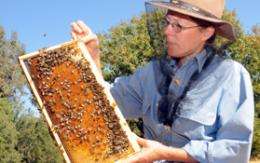Increasing genetic diversity of honey bees needed

(PhysOrg.com) -- Increasing the overall genetic diversity of honey bees will lead to healthier and hardier bees that can better fight off parasites, pathogens and pests, says bee breeder-geneticist Susan Cobey of the University of California, Davis, and Washington State University.
Just as stock improvement has served the poultry, dairy and swine industries well, the beekeeping industry needs access "to stocks of origin or standardized evaluation and stock improvement programs," Cobey said.
Cobey is the lead author of the chapter "Status of Breeding Practices and Genetic Diversity in Domestic U.S. Honey Bees" of the newly published book, "Honey Bee Colony Health: Challenges and Sustainable Solution."
"The many problems that currently face the U.S. honey bee population have underscored the need for sufficient genetic diversity at the colony, breeding, and population levels," wrote Cobey and colleagues Walter "Steve" Sheppard, professor and chair of the WSU Department of Entomology and David Tarpy of North Carolina State University, formerly a graduate student at UC Davis.
"Genetic diversity has been reduced by three distinct bottleneck events, namely the limited historical importation of a small subset sampling of a few honey bee subspecies, the selection pressure of parasites and pathogens (particularly parasitic mites) and the consolidated commercial queen-production practices that use a small number of queen mothers in the breeding population," Cobey pointed out.
The honey bee, Apis mellifera, originated in the Old World where it diverged into more than two dozen recognized subspecies, they related. However, only nine of the more than two dozen Old World subspecies ever made it to the United States and only two of these are recognizable today.
European colonists brought one subspecies, Apis mellifera mellifera or "the Dark Bee" of Northern Europe, to America in 1622, establishing it in the Jamestown colony. The bee was the only honey bee present in the United States for the next 239 years (1622 until 1861).
The Italian or golden honey bee, Apis mellifera ligustica, was introduced into the United States in 1859 and is now the most common honey bee in the United States. "Currently available U.S. honey bees are primarily derived from two European subspecies, A. m. carnica and A. m. ligustica," the bee scientists said.
The U.S. ban on the importation of bees in 1922 to ward off a tracheal mite (Acarapis woodi) further aggravated the genetic bottleneck. Today the No.1 enemy of the beekeeping industry is the parasitic Varroa mite (Varroa destructor), which has played a major role in the crippling decline of the U.S. honey bee population.
Found in virtually all bee colonies in the United States, it feeds on bee blood, can transmit diseases and generally weakens the bee immune system.
What's being done? "In the U.S. the recognized need to increase genetic diversity and strengthen selection programs of commercial breeding stocks has resulted in collaborative efforts among universities, government researchers, and the queen industry," according to Cobey, Sheppard and Tarpy. "The current challenges facing the beekeeping industry and new technologies being developed are pushing beekeeping into a new era."
To increase genetic diversity in the U.S. honey bee gene pool, Cobey and Sheppard are importing honey bee germplasm or semen of several subspecies of European honey bees and inseminating virgin queens of domestic breeding stock. They are also working on diagnostic programs to assist beekeepers to assess colony health and to evaluate commercial breeding stocks.
Cobey, who teaches queen-bee rearing classes and queen bee instrumental insemination at UC Davis and WSU, joined UC Davis in May 2007. Her research focuses on identifying, selecting and enhancing honey bee stocks that show increasing levels of resistance to pests and diseases. Cobey developed the New World Carniolan stock, a dark, winter hardy race of honey bees, in the early 1980s by back-crossing stocks collected from throughout the United States and Canada to create a more pure strain.
Sheppard, who leads the Apis Molecular Systematics Laboratory at WSU, studies population genetics and evolution of honey bees, insect introductions and mechanisms of genetic differentiation. His work was featured in a recent edition of the Washington State University Magazine.
Tarpy, now an associate professor and Extension apiculturist, at North Carolina State University, received his doctorate in entomology from UC Davis in 2000. He studied with Robert Page, emeritus professor of entomology at UC Davis who later became the vice provost and dean of the College of Liberal Arts and Sciences and Foundation Professor of Life Sciences, Arizona State University.
Overall, the 21-chapter book "provides an overview of the complexities of honey bee health, including colony collapse disorder (CCD)," Cobey said.
The book, published by CRC Press, Taylor & Francis Group, Boca Raton, Fla., is edited by research entomologist Diana Sammataro of the Carl Hayden Bee Research Center, Tucson, Ariz., part of the Agricultural Research Service, U.S. Department of Agriculture; and Jay Yoder, professor of microbiology and immunology, Wittenberg University, Springfield, Ohio.
The purpose of the book, the editors wrote, "is to provide collective knowledge from the many scientists who work with bees, to share their research, and to inspire future generations of researchers, beekeepers and students to continue to study bees and keep them healthy and pollinating."
The chapters, written by noted bee scientists, range from information on pathogens, parasites, pests and viruses to problems encountered in bee pollination, nutrition, disease outbreak and breeding practices.
Provided by University of California, Davis



















